info@gerb.com
Seismic Retrofit of a Hospital
Critical infrastructure, such as hospitals must be protected against earthquakes
Slobozia, Romania – 120 km east of Bucharest is the capital of Ialomiţa County. A region that is regularly hit by small to moderate earthquakes. In 2020 alone, the Ialomiţa was affected by 9 earthquakes. Back in 2007, it was clear the hospital, which is providing health care for more than 250,000 people, needed a seismic protection upgrade.
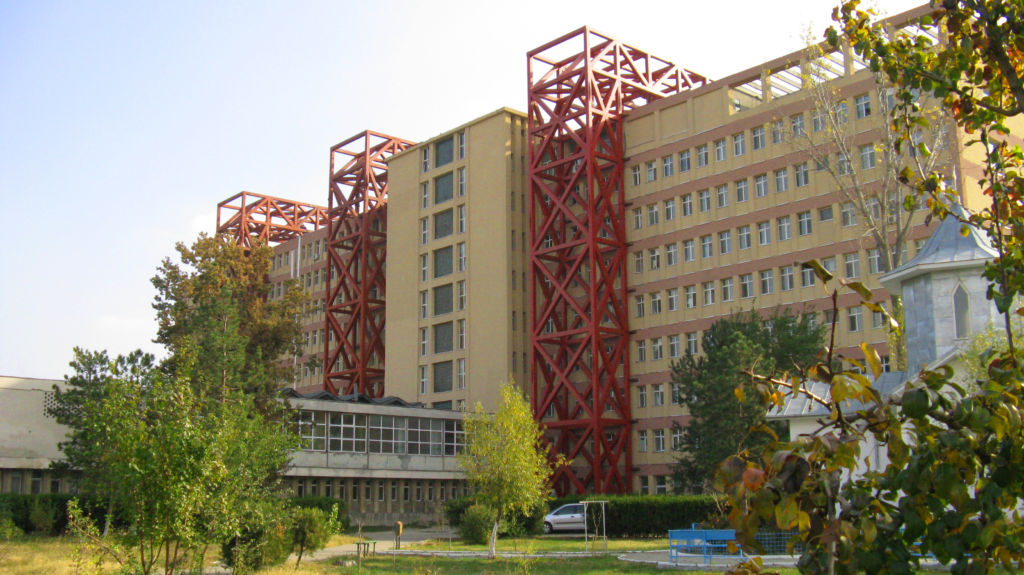
Challenge
The project challenged on two levels. First, the structure of Slobazia hospital was already built and therefore seismic control solutions were needed to develop that can adapt to already existing architecture. Furthermore “hammering effects” were feared as the building consists of 5 parts and the original design did not include high seismic effects. The second challenging factor had a deeper impact on working process: Because of the hospitals importance for health care in this region of Romania, the temporarily closure was not acceptable and treatment of inpatients had to continue.
Technical Facts:
Structure: Reinforced concrete
Design load: 177,400 kN
Vibration Source: Earthquake
Building frequencies: 1.6 – 2.0 Hz
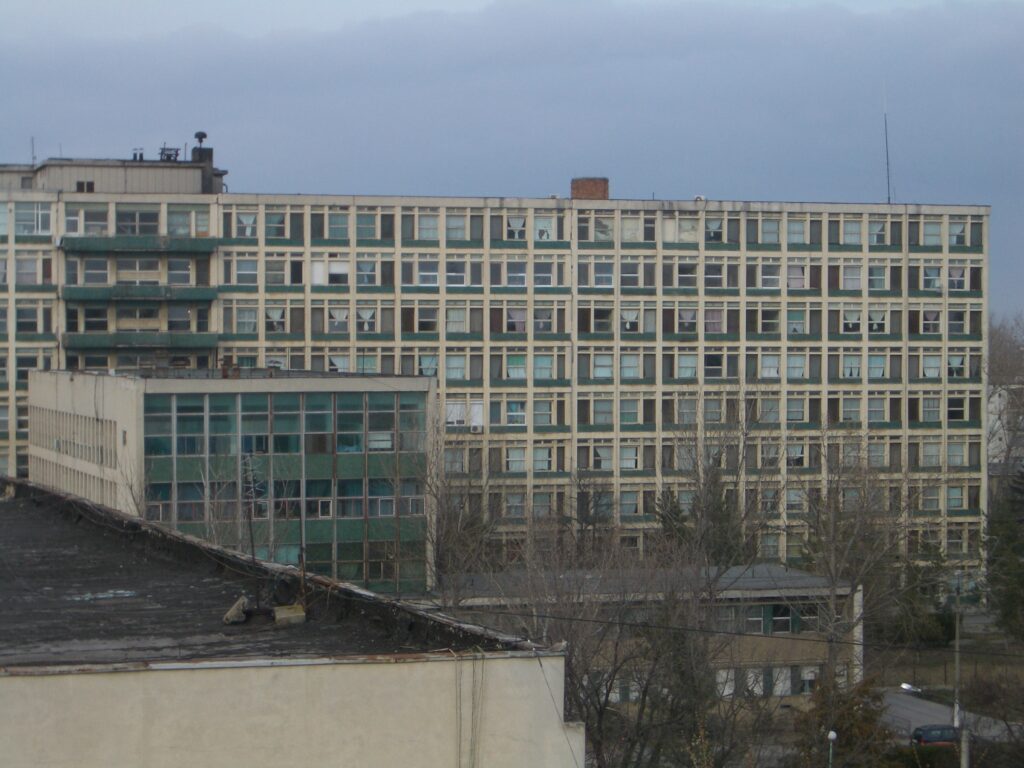
Solution
The retrofitting strategy consisted of the combination of conventional strengthening and the arrangement of a GERB Tuned Mass Control System (TMCS).
A TMCS provides a passively working seismic protection. The system absorbs horizontal forces and is practically maintenance-free. In comparison to conventional strengthening methods only, the building can be used during the installation of TMCS.
As a first step, the slabs at the roof are coupled to avoid relative motion between parts of the building. Space for additional shear walls within the structure was very limited and furthermore the use of the building must not be disturbed. Thus, three new steel frame structures are arranged outside the building.
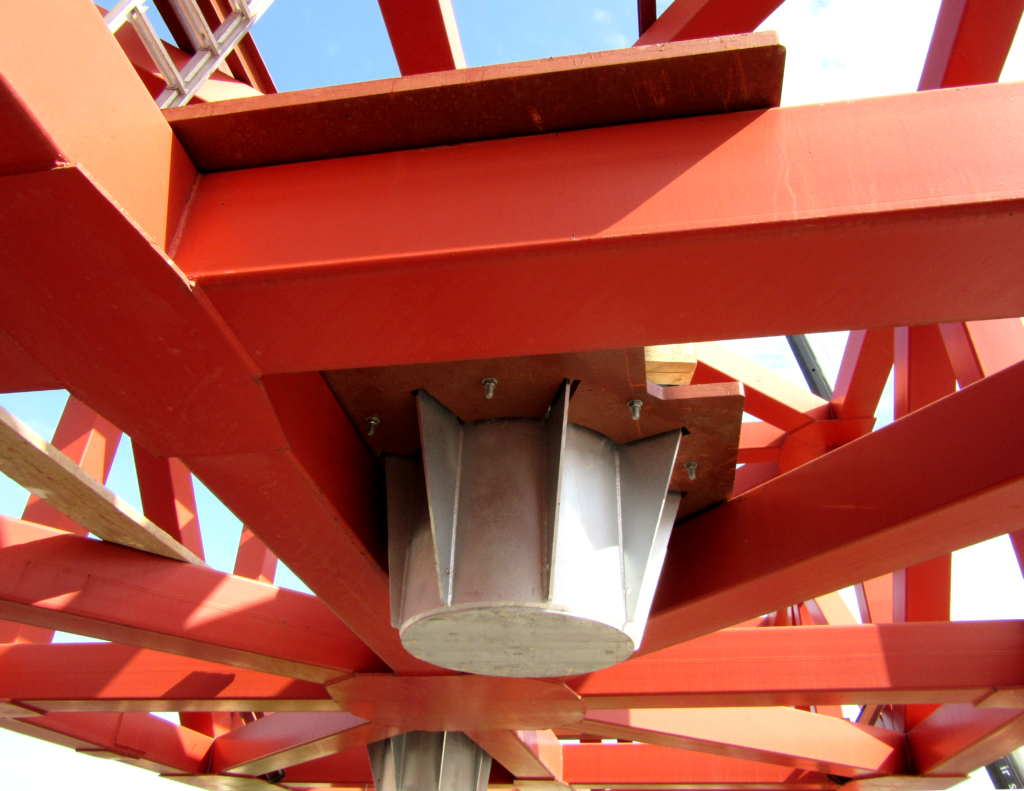
Implementation
The 3 mass blocks of reinforced concrete form the main part of the TMCS. Each bay of the steel frames are equipped with one of these blocks. The concrete structures are hanging on ropes inside the steel frame and are elastically connected to the steel frame by helical steel springs and Viscodampers®.


Result
The TMCS yields significicantly reduced seismic results in terms of relative displacements, interstory drift, absolute acclerations and internal forces. The extensive test program reveals that the TMCS reduces the structural responses in a range of about 25 to 40 %.
The retrofit of the hospital was sucessfully finished in 2014 and presented to the public by the Prime Minister and District Health Minister of Ialomiţa County.
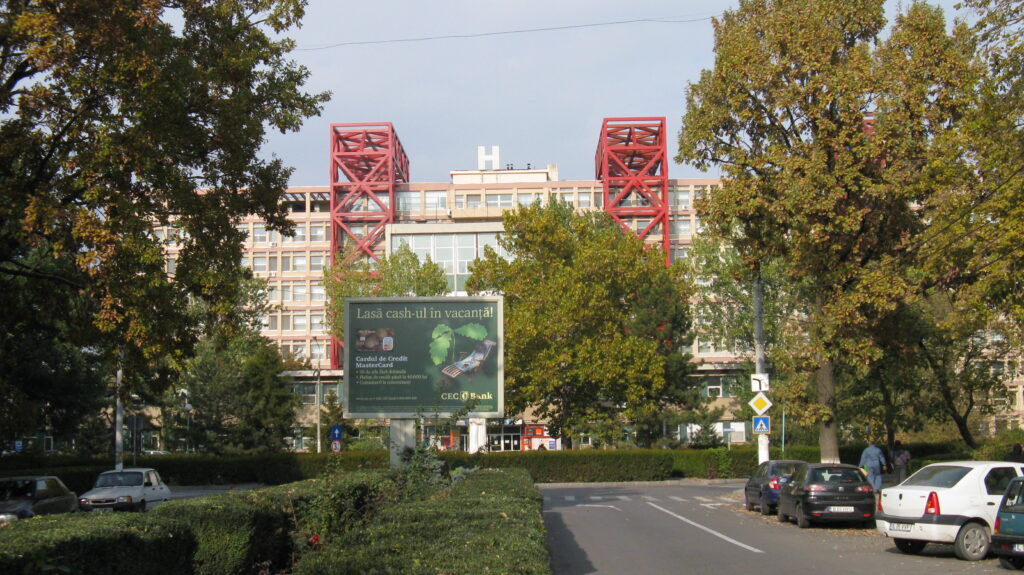
Acknowledgement:
We would like to explicitly thank Mr. Traian Popp here. Without him this project would not have been possible. It still fills us with great sadness that this excellent engineer, friend and personality passed away in June 2021.
Further Resources
You need further information on this topic?
Please do not hesitate to contact us with your individual question.
One of our project engineers will get back to you shortly.
Seismic Retrofit of a Hospital
Critical infrastructure, such as hospitals must be protected against earthquakes
Slobozia, Romania – 120 km east of Bucharest is the capital of Ialomiţa County. A region that is regularly hit by small to moderate earthquakes. In 2020 alone, the Ialomiţa was affected by 9 earthquakes. Back in 2007, it was clear the hospital, which is providing health care for more than 250,000 people, needed a seismic protection upgrade.

Seismic Retrofit of a Hospital
Critical infrastructure, such as hospitals must be protected against earthquakes
Slobozia, Romania – 120 km east of Bucharest is the capital of Ialomiţa County. A region that is regularly hit by small to moderate earthquakes. In 2020 alone, the Ialomiţa was affected by 9 earthquakes. Back in 2007, it was clear the hospital, which is providing health care for more than 250,000 people, needed a seismic protection upgrade.

Challenge
The project challenged on two levels. First, the structure of Slobazia hospital was already built and therefore seismic control solutions were needed to develop that can adapt to already existing architecture. Furthermore “hammering effects” were feared as the building consists of 5 parts and the original design did not include high seismic effects. The second challenging factor had a deeper impact on working process: Because of the hospitals importance for health care in this region of Romania, the temporarily closure was not acceptable and treatment of inpatients had to continue.
Technical Facts:
Structure: Reinforced concrete
Design load: 177,400 kN
Vibration Source: Earthquake
Building frequencies: 1.6-2.0 Hz

Challenge
The project challenged on two levels. First, the structure of Slobazia hospital was already built and therefore seismic control solutions were needed to develop that can adapt to already existing architecture. Furthermore “hammering effects” were feared as the building consists of 5 parts and the original design did not include high seismic effects. The second challenging factor had a deeper impact on working process: Because of the hospitals importance for health care in this region of Romania, the temporarily closure was not acceptable and treatment of inpatients had to continue.
Further Technical Facts:
Structure: Reinforced concrete
Design load: 177,400 kN
Vibration Source: Earthquake
Support frequency: 1.6 – 2.0 Hz

Solution
The retrofitting strategy consisted of the combination of conventional strengthening and the arrangement of a GERB Tuned Mass Control System (TMCS).
A TMCS provides a passively working seismic protection. The system absorbs horizontal forces and is practically maintenance-free. In comparison to conventional strengthening methods only, the building can be used during the installation of TMCS.
As a first step, the slabs at the roof are coupled to avoid relative motion between parts of the building. Space for additional shear walls within the structure was very limited and furthermore the use of the building must not be disturbed. Thus, three new steel frame structures are arranged outside the building.

Solution
The retrofitting strategy consisted of the combination of conventional strengthening and the arrangement of a GERB Tuned Mass Control System (TMCS).
A TMCS provides a passively working seismic protection. The system absorbs horizontal forces and is practically maintenance-free. In comparison to conventional strengthening methods only, the building can be used during the installation of TMCS.
As a first step, the slabs at the roof are coupled to avoid relative motion between parts of the building. Space for additional shear walls within the structure was very limited and furthermore the use of the building must not be disturbed. Thus, three new steel frame structures are arranged outside the building.

Implementation
The 3 mass blocks of reinforced concrete form the main part of the TMCS. Each bay of the steel frames are equipped with one of these blocks. The concrete structures are hanging on ropes inside the steel frame and are elastically connected to the steel frame by helical steel springs and Viscodampers®.


Result
The TMCS yields significicantly reduced seismic results in terms of relative displacements, interstory drift, absolute acclerations and internal forces. The extensive test program reveals that the TMCS reduces the structural responses in a range of about 25 to 40 %.
The retrofit of the hospital was sucessfully finished in 2014 and presented to the public by the Prime Minister and District Health Minister of Ialomiţa County.
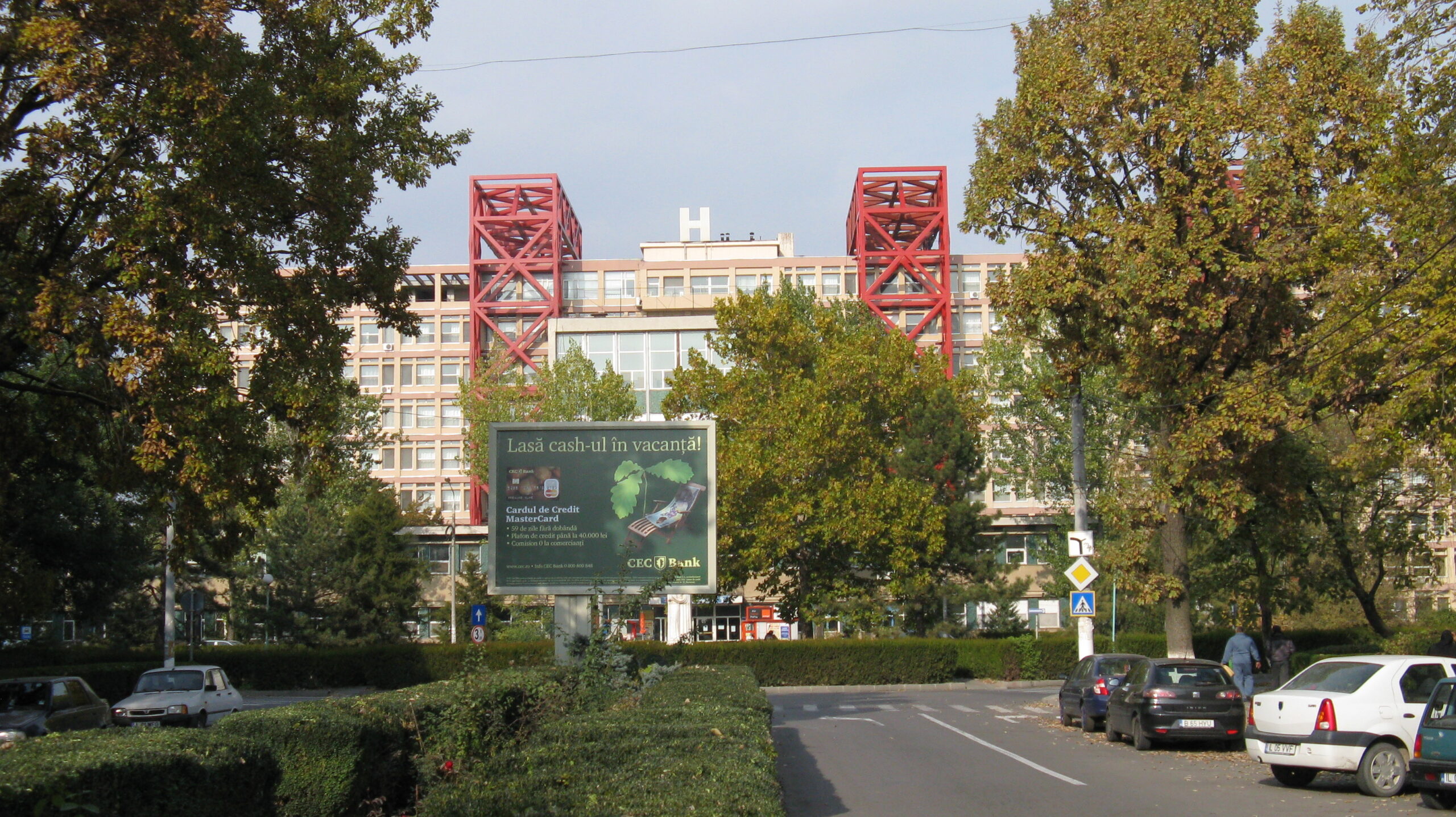
Acknowledgement:
We would like to explicitly thank Mr. Traian Popp here. Without him this project would not have been possible. It still fills us with great sadness that this excellent engineer, friend and personality passed away in June 2021.
Implementation
The 3 mass blocks of reinforced concrete form the main part of the TMCS. Each bay of the steel frames are equipped with one of these blocks. The concrete structures are hanging on ropes inside the steel frame and are elastically connected to the steel frame by helical steel springs and Viscodampers®.


Result
The TMCS yields significicantly reduced seismic results in terms of relative displacements, interstory drift, absolute acclerations and internal forces. The extensive test program reveals that the TMCS reduces the structural responses in a range of about 25 to 40 %.
The retrofit of the hospital was sucessfully finished in 2014 and presented to the public by the Prime Minister and District Health Minister of Ialomiţa County.

Acknowledgement:
We would like to explicitly thank Mr. Traian Popp here. Without him this project would not have been possible. It still fills us with great sadness that this excellent engineer, friend and personality passed away in June 2021.
Share this post
Further Resources
You need further information on this topic?
Please do not hesitate to contact us with your individual question.
One of our project engineers will get back to you shortly.
Further Resources
You need further information on this topic?
Please do not hesitate to contact us with your individual question.
One of our project engineers will get back to you shortly.